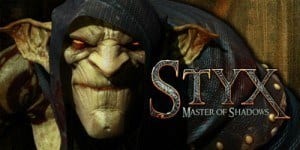
There’s nothing more exciting than an indie game releasing on a console like the Xbox One. You cheer for the underdog, which is what indies are, so when Styx: Master of Shadows released through the ID@Xbox program, I was excited to see what it was all about. It looks beautiful and implements a heavy stealth aspect, which is difficult to deliver effectively. The reason stealth is so hard is because oftentimes stealth-focused games can get tedious, which is exactly what happens with Styx.
If Styx were laid out like a pie, with eight equal pieces, the game would be wonderful, with few negatives. That’s not how games work though and, using the same pie analogy, seven pieces of the total are well developed and presented to players in enjoyable, or at least passable, ways. Because the game leans so heavily on stealth, and does a great job with it, the combat is a secondary event, used only when you fail at sneaking.
To be blunt, the combat is terrible.

But let’s return to that, because there’s a lot to enjoy within Styx: Master of Shadows. First, Styx is a goblin; a vicious conniving sunnavabitch. He’s a thief, an assassin, and an ugly character to boot, which makes the game interesting. How often do you play the bad guy? And although Styx is a well-designed creature, boney and ugly in just the right places, his voice doesn’t quite fit. It’s more reminiscent of “just some guy,” than it is of a deadly, twisted goblin.

The stealth works wonderful too, using sounds contextually, with players treading softer on carpets, while slapping their feet on stone in exactly the way you’d expect. Shadows are present, even during the day, for Styx to slip into so he can avoid detection, but the sense of darkness is off. Day or night, inside or out, as you move into the shadows the only indication, beyond a very easy-to-miss change of lighting, is that Styx’s tattoo will begin to glow. While you’re in shadows, enemies have almost no chance to detect you, unless you’re in sprint mode, which is rarely necessary. The creeping from corner to corner and shadow to shadow is very well done and you’ll hardly feel like the game is being “cheap” when you’re detected.
The level design is best described as surprisingly impressive. Each area includes a map that makes it seem far smaller than it is, partly due to the immense verticality that they all contain. When you’re staring at a swath of soldiers or any of the other enemies, bugs or other “creatures” I’d rather not name for fear of spoiling the plot, odds are there’s a way to sneak past them on the ground by using debris or ledges to hide your path, or above them via chandeliers, scalable candlesticks, rafters, and other terrain. There’s always multiple ways to approach any particular problem, and that’s a testament to the level design.

Character development is also included, giving you a chance to increase Styx’s skills. Stealth, combat, mobility, and other options are available, depending on your style of play. You can increase the number of potions and vials you carry, throwing knives, or add skills to your already deadly repertoire. Styx uses XP gained throughout each level to increase his skills, but unfortunately you can only increase your skills back at your hideout, which you visit in between missions. Each mission consists of three or four areas and you only end up visiting the hideout a handful of times. It seems a poor design choice to limit players in this way and could be an artificial roadblock to prevent players from getting too powerful too fast.
Your objectives are straight forward during each mission, though the side objectives and collectibles do add some variance to what you’ll be doing. You can speed through each level, and you’ll be rewarded if you do, but for replayability you’ll have the option to take control of Styx and go back for items you’ve missed. The monologue that Styx has also plays into the overall story as well, making it seem like he’s addicted to the nectar that leaks from the World Tree, which actually works as the source of his skills, invisibility and “special sight” that allows you to see enemies, pathways, and collectibles throughout each level.

The biggest issue with Styx’s chatter is that he includes curse words seemingly for the sake of it. He, and guards for that matter, will throw out random swearing in what seems like a poor way to prove how “adult” the game is, when in reality it makes it seem far more juvenile than it should be. Occasional cursing would have worked, even making particular moments seem more powerful, but the gratuitous use of certain words will make you shake your head in disgust.
Finally, the combat is what ruined Styx: Master of Shadows for me. Because the game is often a mixture of trial and error, you’ll find yourself often being spotted or grabbed by patrolling guards or other enemies. When this happens, you’re thrown into a mano-a-mano combat with your assailant, essentially a minigame. The objective is to time the enemy’s attacks, parrying them a number of times before you can deliver a killing blow. There are multiple problems with this approach. First, the timing seems “off” for Styx parrying attacks, though that could be a deficiency in player ability, i.e. I sucked at it.

The other issue, and perhaps the biggest problem, is that when you’re facing off against an enemy, he shouts in alarm and other enemies will come to his aid. When this happens, you’re still stuck in the one-versus-one combat, with enemies raining down blows from all directions. Because the combat feels so cheap and is so unenjoyable, you’re better off simply reloading your game each and every time you get caught. I mentioned that the game is very “trial and error,” so that means you may end up loading one particular area dozens of times.
I know I did.
If you’re a big fan of stealth-heavy games, Styx: Master of Shadows is for you. There are seven levels, each with three or four sprawling areas to complete, collectibles, a ton of character skills, and different challenges to complete throughout the game, making the $30 pricetag seemingly justified. However, if you’re looking for variation in gameplay you will not find it here. The combat is frustrating and seems like it was shoehorned in due to time or budget limitations. It’s poor enough that it, despite playing for hours and hours, I still hadn’t finished the game because of the hundreds of reloads I had to endure.
With a new cast of voice actors and a new combat system, even one that mimics Arkham’s or Shadow of Mordor ‘s, the team behind Styx has a real winner. Until then, you should only dedicate time to this if you’re a hardcore fan of stealth, otherwise you can pass.
Overall Score: 5 out of 10















